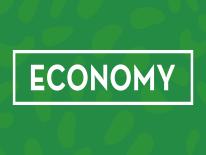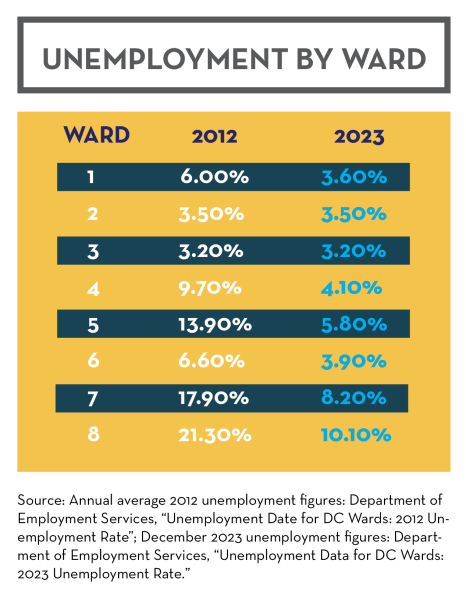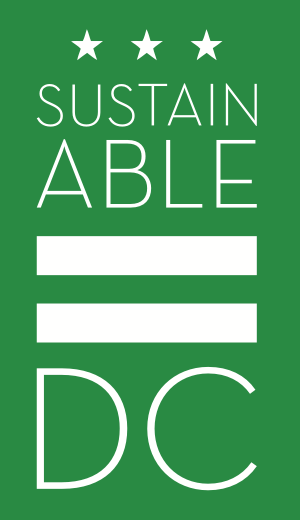

 Meeting the District’s sustainability goals requires a robust local green economy. An inclusive green economy, as defined by the United Nations Environment Program, is “one that improves human well-being and builds social equity while reducing environmental risks and scarcities.” In the District, this means empowering businesses and residents to transition to low-carbon, resource-efficient systems while reducing unemployment broadly and eliminating unequal unemployment rates across the city.
Meeting the District’s sustainability goals requires a robust local green economy. An inclusive green economy, as defined by the United Nations Environment Program, is “one that improves human well-being and builds social equity while reducing environmental risks and scarcities.” In the District, this means empowering businesses and residents to transition to low-carbon, resource-efficient systems while reducing unemployment broadly and eliminating unequal unemployment rates across the city.
To prepare residents—especially unemployed and underemployed residents—to work in the green economy, training programs with wraparound services are necessary. The District Government has several successful existing models for green job training programs, including Green Trades DC, which recruits and trains District residents for careers as journeymen electricians and the Green Zone Environmental Program, which teaches young adults about energy and environmental issues, and provides work experience on community environmental projects.
Goal 1: Grow and diversify the District’s economy, focusing on sustainability, climate, and resilience industries
Status:  The average progress score of actions under this goal is between “Moderate Progress” (2 out of 4) and “Significant Progress” (3 out of 4). See annual progress reports for details.
The average progress score of actions under this goal is between “Moderate Progress” (2 out of 4) and “Significant Progress” (3 out of 4). See annual progress reports for details.
What's Been Done?
- The DC Community Anchor Partnership encourages increased procurement with DC-based minority-owned businesses by anchor institutions such as hospitals and universities.
- The Deputy Mayor for Planning and Economic Development managed the Makerspace Marketplace Grant Pilot to provide funding to qualified operators of new or existing makerspaces that combine access to production equipment and retail space.
- The Department of Energy and Environment and the Department of Small and Local Business Development provide training for businesses on sustainability topics such as reducing food waste and hosting electric vehicle chargers.
- The DC Green Bank was launched in 2020 and provides financing options for clean energy, energy and resource efficiency, and resilience.
- The Fabrication Lab at the Martin Luther King Jr. Memorial Library serves as a maker space, allowing residents access to equipment such as 3-D printers and sewing machines.
- The District regularly offers grants to support businesses with sustainability initiatives such as reducing food waste and encouraging reuse, and to upskill businesses so they’re better prepared to pursue energy efficiency and other green building contracts.
What is Left to Do?
- Continue providing training, financial assistance, and marketing for jobs in the sustainability field.
- Coordinate with anchor institutions such as hospitals and universities to encourage purchasing from local sustainability-related businesses.
- Work with private partners to support new incubators and “maker spaces” with a focus on communities most in need.
- Increase the number of businesses that offer sustainable products and services.
- Continue providing training and connecting District businesses to financial resources to operate more sustainably.
Goal 2: Train District residents to be competitive for livable wage jobs in growing industries such as sustainability, the environment, and resilience.
Status:  The average progress score of actions under this goal is “Moderate Progress” (2 out of 4). See annual progress reports for details.
The average progress score of actions under this goal is “Moderate Progress” (2 out of 4). See annual progress reports for details.
What's Been Done?
- The District offers several workforce programs with a sustainability focus, such as training for electrical work and green infrastructure, and programs to expose youth to environmental careers.
- The Department of Energy and Environment has collaborated with local and regional partners to identify fast-growing sustainability fields and where workforce gaps need to be filled in order to meet sustainability goals.
- The Department of Energy and Environment developed the DC Green Buildings Career Map to map out career paths in the green building industry, including typical skills and certifications needed to advance in the field.
What is Left to Do?
- Partner with the Workforce Investment Council to identify the fastest growing sustainability fields for future job training programs.
- Continue connecting underemployed residents with jobs in growing sustainability fields.
- Create new paid job opportunities in sustainability fi elds for young adults and high school students.
- Track the economic impact of jobs in sustainability on the local economy.
Last updated: June 2025


